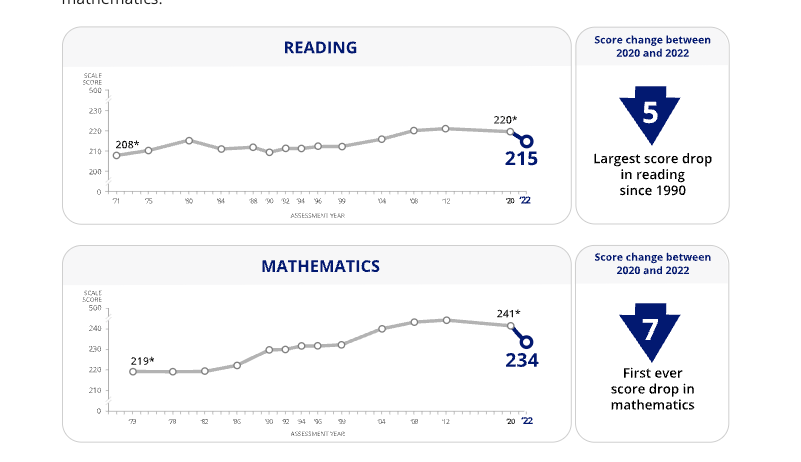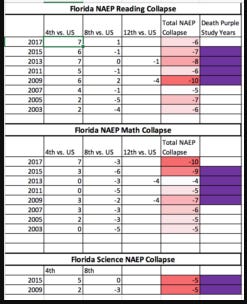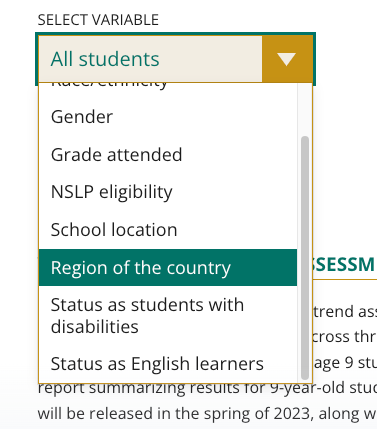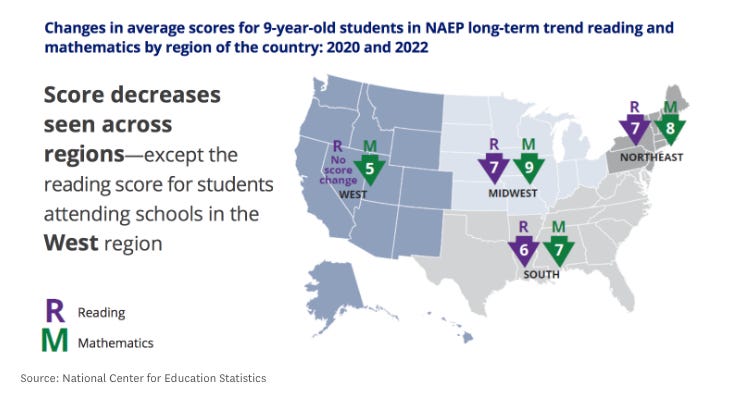Billy Townsend: Is the fake NAEP hiding state-level “test-score loss” to protect Florida?
Billy Townsend questions what, exactly, is going on with this year’s round of NAEP scores. Reposted by permission.
America’s NAEP standardized testing organism is a many-tentacled, maliciously clever, grift Octopus.
It squeezes itself effortlessly into whatever social and political hole the moment demands in order to get its suction cups on whatever life remains in a dead American education model.
Not surprisingly, the NAEP refuses to seriously analyze, report, and publicly denounce political abuse of its own results, as I’ve documented repeatedly. See this article I wrote a few years ago about Florida’s disastrous, unacknowledged, generational NAEP performance, which is defined by massive “test score loss” with age.
In short, NAEP-world is a gross, entirely political, suite of human-sorting and punishment tools. It exists to tell very rich hobbyists whatever will flatter their egos and sustain the flow of anti-public good and human development checks to education foundations and think tanks. It only benefits people who abuse student “data” for fun and profit.
The fake NAEP’s fake, predatory “test score loss” panic
American educrats and their aligned education pundits/politicians can’t be bothered to fight the Proud Boys for the existence of a public education system. (In truth, they share an organized-teacher-hating coalition with them.) But they are worked up about these 2022 “scores” on the 4th grade “NAEP.”

That image shows 5 and 7-point national drops, respectively, on the “2022 NAEP” Reading and Math bubble tests for 4th graders.
The latest results of the National Assessment of Educational Progress reveal historically large drops in math and reading scores for US public-school students. The findings are an indictment of school closures that went on for far too long, pushed by teachers unions and some of their political allies. They also show why recovering the ground students have lost is a national emergency.
Literally every part of that is false. Don’t believe me; believe the NAEP octopus itself, which will quietly tell you the following if you look really, really closely at the fine print on its website:
- These NAEP scores aren’t actually NAEP scores. “The NAEP test,” as commonly reported, happens every two years (disrupted by the pandemic) and tests kids in 4th, 8th, and sometimes 12th grade. This NAEP is not that NAEP. It’s a sort of sub-NAEP called a “Long Term Trend Assessment.” It tested fewer than 8,000 American 4th graders and ignored 8th and 12th graders. NAEP’s explanation here:
NCES decided to administer the long-term trend assessment for age 9 students─the last NAEP assessment given before the pandemic in March 2020─after two years rather than four years in order to provide data on the COVID-19 pandemic disruptions to student learning. The assessments were administered from January to March in 2020 and 2022, respectively. About 7,400 age 9 students from 410 schools participated in each subject in 2022. Ninety-two percent of schools from 2022 were sampled in 2020.
- Nothing in the new fake NAEP data remotely correlates with ANY in-person vs. remote dynamic at all. You can find a decent, simplified LTT Q-and-A here. Key remote v. in-person answer excerpted below. Note the part in bold:
The fact that city schools, where students were most likely to have missed more in-person days, held steady in reading (see above) is a sign that remote learning wasn’t always so detrimental. Suburban and small town students, who tended to have more in-person days, fared worse.
Accompanying the NAEP test was a student survey, which asked students if they learned remotely even once during the 2020-21 school year. But it didn’t ask 9-year-olds to count the number of remote days, so it’s impossible to say if more days of remote school led to worse outcomes.
15 > 5 or 7: “Just being in Florida since 2003” test score loss is worse than COVID test score loss
I find this fake NAEP hand-wringing amusing, considering how thoroughly the educrat industrial complex has managed to ignore Florida’s much larger, far more sustained test score loss on the NAEP, compared to other states and the national average.
Here’s how it plays out in a key paragraph from my Florida NAEP article a few years ago. Note the parts in bold:
Florida was tied for 7th on the 2017 4th grade NAEP Math test. And it was tied for 36th that same year in 8th grade Math. (I’m excluding Department of Defense schools because they are not a state.) Florida was three points behind national leader Massachusetts on average Math NAEP score in 4th grade. By 8th grade, it was 18 points behind. A very similar collapse occurs in Reading. Go look for yourself at the NAEP’s “national report card.”
That is what you call an accelerating achievement gap. This is what test-obsession and teacher hatred and transparently fake “accountability” gets you: a catastrophic collapse in test results.
LOL. That’s a 15-point Math NAEP “learning loss” for Florida relative to Massachusetts. 15! Fifteen is a lot bigger than 5 or 7.
And as the chart below shows, on every NAEP between 2003 and 2017, after 4th grade, Florida’s NAEP score relative to the national average plunged for:
- Reading: Between 5 and 10 points, with an average 7-point collapse.
- Math: Between 4 and 10 points, for an average 6.4 points. But it’s worth noting that 2015 and 2017, the last two years for which I did this calculation, produced massive 9 and 10-point Math collapses after 4th grade.

A pandemic every NAEP cycle for Florida
These are catastrophic, pandemic-level learning loss numbers, relative to the national average, every year in the Test State of Florida. Florida is an education pandemic all its own.
Yet, nobody in the entire cross-partisan American educrat industrial complex cares. None has ever screamed about the crisis in JebSantis’ Florida.
Indeed, in 2017, the state of Florida and its grifter educrat friends bragged about the state’s NAEP results, which included a 10-point Math collapse after 4th-grade relative to the national average. That’s a much greater drop than either of the NAEP numbers used to further the “learning loss” panic. You’ll see the official press release brag my article. And, of course, Michael Bloomberg did not consider this an American tragedy.
Any slightly more than cursory look at Florida’s state-level NAEP numbers — and our own state growth tests — makes it obvious that:
- Florida historically games the 4th grade NAEP with mass 3rd grade retention and a large, untested private voucher system that acts as a dumping ground for “testing refugees” likely to do poorly on the 4th grade NAEP and 3rd grade state growth tests.
- Florida’s performance on the NAEP collapses catastrophically in the older grades as those vouchers kids come back to the public system, grifted; as the life-ruining effects of retention take hold; and as the useless Florida Model of political test sorting disengages Florida kids from actual learning. It has been this way since at least 2003. It’s Jeb Bush’s core legacy.
So, quick questions, NAEP lovers: would you rather have your child score high in 4th grade? Or 12th grade? And why do you pretend like the 8th grade and 12th grade tests don’t exist?
The Florida/NAEP idea/grift — “learn to read, read to learn” — is that relatively higher scores in 3rd and 4th grade will lead to high scores and better outcomes for older kids and in later grades. That’s the only point of caring about a reading score at age 8 or 9.
But that doesn’t happen in America, even in states that don’t fully collapse with age like Florida.
Here’s one of the few articles I’ve ever seen that actually addresses this, from Natalie Wexler of Forbes. “Learning loss” has been a thing with age everywhere. It’s just more spectacular in the “Test State of Florida.”
Yet, to my knowledge, the NAEP has never publicly acknowledged or commented on the regular Florida NAEP collapse — or the national pattern of “losing ground” or “falling behind” with age.
And the entire national education data and reporting grift industrial complex refuses to acknowledge it exists — probably because it would embarrass Jeb Bush and Barack Obama, who agree on almost everything in education, and their funders.
After all, as the famous saying goes: it’s hard to get a grifting, test-loving, “Chalkbeat” reformer to understand a thing if their Walton or Gates Foundation funding depends on them not understanding it.
The hilarious, grifty NAEP shift to “region” and “location”
I wanted to see what happened to the Florida NAEP pattern when COVID disrupted mass 3rd grade retention — and possibly “test-refugee” voucher enrollment numbers, which are impossible to get. (That’s a different article.)
My hypothesis: Florida’s 4th grade NAEP test scores would drop, relative to other states, but the collapse from 4th to 8th to 12th would shrink, relative to other states, without the artificial 4th grade score inflation.
Florida’s silent political reaction to these new “NAEP” scores encouraged my hypothesis.
Based on all the NAEP scare headlines, I also assumed “the NAEP” meant the NAEP, not a sub-NAEP limited to a handful of 4th graders. And I assumed Florida’s silence meant 4th grade NAEP numbers plunged in the “Free State of Florida,” too. Florida generally crows every cycle about our rigged 4th grade NAEP scores and ignores 8th and 12th while the NAEP nods quietly with approval.
I was curious if the higher grade NAEP collapse continued this time.
So imagine my giggling when I discovered: 1) No older kids got tested. 2) You cannot break down the “2022 NAEP” by state — only “region of the country” and “location” (city, rural, town, suburban, for which I could find no definitions. LOL.)

In fairness, it seems like region has been a thing for NAEP — a useless thing, beyond its implied sectional politics — since 2008.
But if NAEP can break down scores by “region” and “location,” then it can break it down by state. Why did it not do this?
I haven’t found an explanation for that either.
But the shielding of the states seems new; and my suspicious nature suspects the NAEP ignored state-level performance to protect the myth of Florida and other states that supposedly had schools full of kids during the 2020-21 school year. (Florida didn’t, Ron DeSantis brags not withstanding. More on that in a second.)
The NAEP exists to build and protect myth, which is why it never challenges the mythology that Bloombergs and Jebs build with its garbage tests — especially when those garbage tests produce data that openly contradicts the myth.
There is no such thing as regional school authority, NAEPers
Out of thin air, the NAEP envisions four “regions of the country:” South, West, Midwest, Northeast.

It is impossible to overstate what a useless unit of comparison this provides.
There is no Superintendent of the South, Chancellor of the West, School Board of the Northeast, or Secretary of the Midwest. Region does not play any governance or funding role. “Region of the country,” is not a thing in education, except for the NAEP, apparently.
That’s because schools are funded and overseen at three levels — local, state, federal.
States tend to have most direct control, although the power and control of local districts varies.
In Florida, local districts are extremely weak — probably weakest in the country — to the point of complete subservience. In every meaningful way, Florida school superintendents and staff work for Ron DeSantis, not elected local school boards.
The federal government is a distant third, behind state and local education funding and oversight.
Here’s how “the NAEP” survey turned out for the regions.

The “West” did clearly “better than the others. Is that because of the big “lib” population centers, where there were lots of extended closings? ¯\_(ツ)_/¯
Such a stupid, useless debate
There is no such thing as measurable “learning loss.”
Learning is far too fuzzy a term to have any meaning in the way educrats are using it. What they mean is “test score loss.” National test scores do not reflect “learning.” They provide justification for human sorting and grist for politicians. Nothing more. They provide no developmental value. None.
Thus, this COVID test score loss “debate” is impossibly dumb and corrupt. It’s almost completely devolved into a useless in-person vs. remote political battle, with the educrat industrial complex basically siding with the Proud Boys about the evils of school closures and masking and organized teachers.
In providing grist for this battle, no data honk I’ve seen has bothered to try to determine how the actual kids who were remote scored compared to kids who were in-person in 2020-21.
In part, that’s because many, many kids, including my own, were both remote and in-person. Ron DeSantis crowed about forcing open Florida schools; but at least 35 to 40 percent of Florida kids started 2020-21 remotely. Some came back quickly, some stayed out the whole year. Many were in between.
In any event, the 5 and 7 point 2021 “collapse” of fourth graders living through a deadly and disruptive pandemic pales when compared to Florida’s fully in-person 10-point loss in 2017, relative to the national average, between 4th and 8th grade Math.
Literally every educrat’s reaction to that is also ¯\_(ツ)_/¯.
I see no reason not to return the favor when they use test score loss as a desperate way to cling to their useless contributions to human development in this country.
